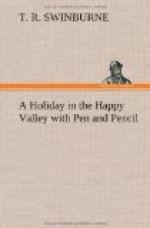We lunched at the fascinating little bungalow at Patan (pronounced “Puttun"), about half-way between Baramula and Srinagar. The Rest House stands back from an apparently extremely populous and thriving village, the inhabitants whereof were all engaged in conversation of a highly animated kind! In the compound stood a fine group of chenar trees (Platanus orientalis) whose noble trunks and graceful branches showed in striking contrast to the slender stems of the poplars. The guide-book informed us that an ancient temple lay in ruins near by, but we trusted to a later visit and determined to push on. By-and-by a fort-crowned hill rose above the tree-tops. This we took to be Hari Parbat, the ancient citadel of Srinagar, and presently, through the poplars and the willows queer wooden huts or chalets began to appear, and the increasing number of men and beasts upon the road showed the proximity of the city.
Ekkas, white-hooded, with jingling bells hung round the scraggy necks of their lean ponies; brown men clad in sort of night-shirts composed of mud-coloured rags; brown dogs, humpy cattle, and children innumerable, swarmed upon the causeway in ever-increasing density until we drew up at the custom-house, and the usual jabber took place among Sabz Ali, the driver, and the officials.
All appeared satisfactory, however, and we were presented with bits of brown paper scrawled over with hieroglyphics which we took to be passes, and drove on, leaving the native town apparently on our left and making a detour through level fields and between rows of poplars, until we swung round and crossed the river by a fine bridge. Here we first got some idea of the city of Srinagar, which lay spread around us, bisected by the broad, but apparently far from sluggish river, which seems here to be about the width of the Thames at Westminster at high water.
Tier upon tier, the rickety wooden houses crowded either bank, the prevailing brown being oddly lighted up by the roofs, which were frequently covered with deep green turf. Here and there the steep and peculiar dome of a Hindu temple flashed like polished silver in the keen sunlight, while around and beyond all rose the ring of the everlasting hills, their peaks clear, yet soft, against a background of cloudless blue.
Close below us stood a remarkably picturesque pile of buildings, of a mixed style of architecture, yet harmonising well enough as a whole with its surroundings. Over it flew a great “banner with a strange device,” and we assumed (and rightly) that we looked upon the palace of His Highness Sir Pratab Singh, Maharajah of Jammu and Kashmir.
Crossing the river, we dived into a bit of the native town, and were much struck by the want of colour as compared with an Indian street. Everything seemed steeped in the same neutral brown—houses, boats, people, and dogs! Emerging from the native street, with its open shop-fronts and teeming life, we drove for some little way along a straight level road, flanked, as usual, on either side by poplars of great size which ran through a brown, flat field, showing traces of recent snow, and finally finished our two-hundred-mile drive in front of the one and only hotel in all Kashmir.




